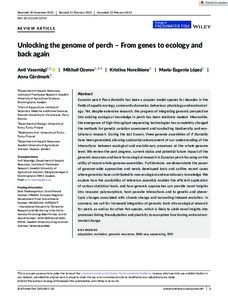Unlocking the genome of perch - From genes to ecology and back again
Vasemägi Anti; Ozerov Mikhail; Noreikiene Kristina; López María-Eugenia; Gårdmark Anna
https://urn.fi/URN:NBN:fi-fe2023041937530
Tiivistelmä
Eurasian perch Perca fluviatilis has been a popular model species for decades in the fields of aquatic ecology, community dynamics, behaviour, physiology and ecotoxicology. Yet, despite extensive research, the progress of integrating genomic perspective into existing ecological knowledge in perch has been relatively modest. Meanwhile, the emergence of high-throughput sequencing technologies has completely changed the methods for genetic variation assessment and conducting biodiversity and evolutionary research. During the last 5 years, three genome assemblies of P. fluviatilis have been generated, allowing substantial advancement of our understanding of the interactions between ecological and evolutionary processes at the whole-genome level. We review the past progress, current status and potential future impact of the genomic resources and tools for ecological research in Eurasian perch focusing on the utility of recent whole-genome assemblies. Furthermore, we demonstrate the power of genome-wide approaches and newly developed tools and outline recent cases where genomics have contributed to new ecological and evolutionary knowledge. We explore how the availability of reference assembly enables the efficient application of various statistical tools, and how genomic approaches can provide novel insights into resource polymorphism, host–parasite interactions and to genetic and phenotypic changes associated with climate change and harvesting-induced evolution. In summary, we call for increased integration of genomic tools into ecological research for perch, as well as for other fish species, which is likely to yield novel insights into processes linking the adaptation and plasticity to ecosystem functioning and environmental change.
Kokoelmat
- Rinnakkaistallenteet [27094]
